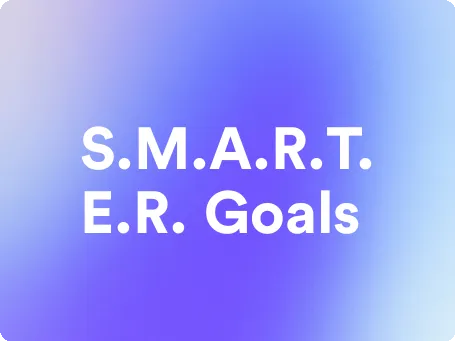s.m.a.r.t.e.r. Goals: Achieving Success through Strategic Planning
This guide will walk you through the essential elements of using s.m.a.r.t.e.r. goals - the productivity method to keep your team productive and engaged.
Try Lark for Free
Setting goals is an integral part of personal and professional growth. The concept of s.m.a.r.t.e.r. goals, an extension of the widely known S.M.A.R.T. framework, provides a structured approach to goal setting by incorporating evaluation and readjustment. The following comprehensive guide explores the origin, benefits, implementation, and best practices for s.m.a.r.t.e.r. goals, offering valuable insights and actionable strategies for individuals and organizations alike.
What are s.m.a.r.t.e.r. goals?
Understanding the Components of s.m.a.r.t.e.r. Goals
Setting s.m.a.r.t.e.r. goals involves considering seven essential elements: specific, measurable, achievable, relevant, time-bound, evaluate, and readjust. These components provide a holistic framework for setting and monitoring goals, ensuring a comprehensive approach towards achieving desired outcomes.
Examples of s.m.a.r.t.e.r. Goals
- Personal Fitness Goal: Rather than simply aiming to "exercise more," a s.m.a.r.t.e.r. approach would be to set a goal of "achieving 10,000 steps a day, five days a week, and reducing body fat percentage by 3% within six months."
- Professional Development Goal: Instead of a vague career aspiration, a s.m.a.r.t.e.r. goal might be "earning a project management certification within the next year, leading to a 10% salary increase and expanded job responsibilities."
- Financial Goal: Rather than stating a general desire to "save money," a s.m.a.r.t.e.r. financial goal would be "increasing monthly savings by 15% over the next year, leading to the accumulation of a six-month emergency fund."
The Origin of s.m.a.r.t.e.r. Goals
Development of the s.m.a.r.t.e.r. Goals Concept
The concept of s.m.a.r.t.e.r. goals builds upon the traditional S.M.A.R.T. criteria, which emerged in the business and project management domain in the 1980s. Over time, thought leaders and management experts recognized the importance of incorporating evaluation and readjustment into the goal-setting process, leading to the evolution of the s.m.a.r.t.e.r. goals framework.
Use Lark to unleash your team productivity.
Who Benefits from s.m.a.r.t.e.r. Goals?
Individuals
Individuals across various spheres of life, including personal development, academics, career advancement, and health, can benefit significantly from leveraging the s.m.a.r.t.e.r. goals approach. By embracing this methodology, individuals can enhance their focus, productivity, and overall satisfaction through structured and realistic goal setting.
Organizations
For businesses and other institutions, implementing s.m.a.r.t.e.r. goals can result in improved productivity, morale, and goal attainment. By incorporating the principles of evaluation and readjustment, organizations can adapt swiftly to changing market dynamics, optimize performance, and foster a culture of continuous improvement.
Pros and Cons of s.m.a.r.t.e.r. Goals
Advantages
- Enhanced Focus and Direction: Setting specific and measurable goals creates clarity and direction, allowing individuals and organizations to channel their efforts effectively.
- Increased Motivation and Accountability: Well-defined goals provide a sense of purpose and accountability, motivating sustained effort and perseverance.
- Improved Decision-Making and Resource Allocation: When goals are clearly outlined, informed decisions can be made regarding the allocation of time, energy, and resources, leading to optimal outcomes.
Disadvantages
- Potential for Rigidity and Limited Adaptability: In some cases, overly stringent goal criteria may hinder adaptability, especially in dynamic environments requiring flexibility.
- Risk of Overlooking Non-Measurable Objectives: The focus on measurable outcomes may inadvertently sideline non-tangible, yet essential, aspects of personal or organizational growth.
- Challenges in Setting Accurate Metrics for Certain Goals: Some objectives, particularly those related to personal development or qualitative improvements, may pose challenges in quantification, leading to ambiguity in measurement.
Learn more about Lark x Productivity
Getting Started with s.m.a.r.t.e.r. Goals
Self-Assessment
Before embarking on the s.m.a.r.t.e.r. goal-setting journey, individuals and organizations must conduct a comprehensive self-assessment to identify their strengths, weaknesses, opportunities, and threats. This introspective process allows for a clear understanding of current standings and paves the way for informed goal setting.
Action Planning
Navigating the world of s.m.a.r.t.e.r. goals involves meticulous action planning, wherein long-term objectives are deconstructed into manageable, measurable milestones. Leveraging various tools and resources, individuals and organizations can create a roadmap for their desired outcomes, ensuring a structured approach towards achievement.
Use Lark to unleash your team productivity.
Actionable Tips for s.m.a.r.t.e.r. Goals
Prioritizing Goals
- Identify high-impact objectives for immediate attention, maximizing the effectiveness of goal pursuit.
- Strike a balance between short-term and long-term goal setting to ensure holistic personal or organizational development.
Utilizing Technology and Tools
- Embrace digital platforms and applications specifically designed for goal tracking, ensuring seamless management and progress monitoring.
- Incorporate visual aids and progress charts, providing a visual representation of achievements and stimulating motivation for continued effort.
Cultivating Accountability and Support
- Engage in accountability partnerships or seek mentorship to foster mutual goal reinforcement and actionable feedback.
- Regularly seek constructive criticism and guidance to refine goal-setting strategies and ensure continued progress.
Do's and Dont's
| Do's | Dont's |
|---|---|
| Set both short-term and long-term goals | Set vague or ambiguous goals |
| Regularly review and adjust goals | Overcommit or set impractical goals |
| Seek feedback and support for goals | Ignore the relevance and impact of the goals |
| Align goals with personal and professional values | Set goals solely based on external expectations |
Conclusion
In conclusion, s.m.a.r.t.e.r. goals serve as a powerful tool for individuals and organizations to realize their full potential and drive sustainable growth and success. By embracing the structured approach of s.m.a.r.t.e.r. goals, it becomes possible to align aspirations with actionable plans while allowing room for adaptability and development. As we continue to navigate the ever-evolving landscapes of personal and professional growth, adopting s.m.a.r.t.e.r. goals is key to unlocking the pathways to fulfillment and accomplishment.
Use Lark to unleash your team productivity.
